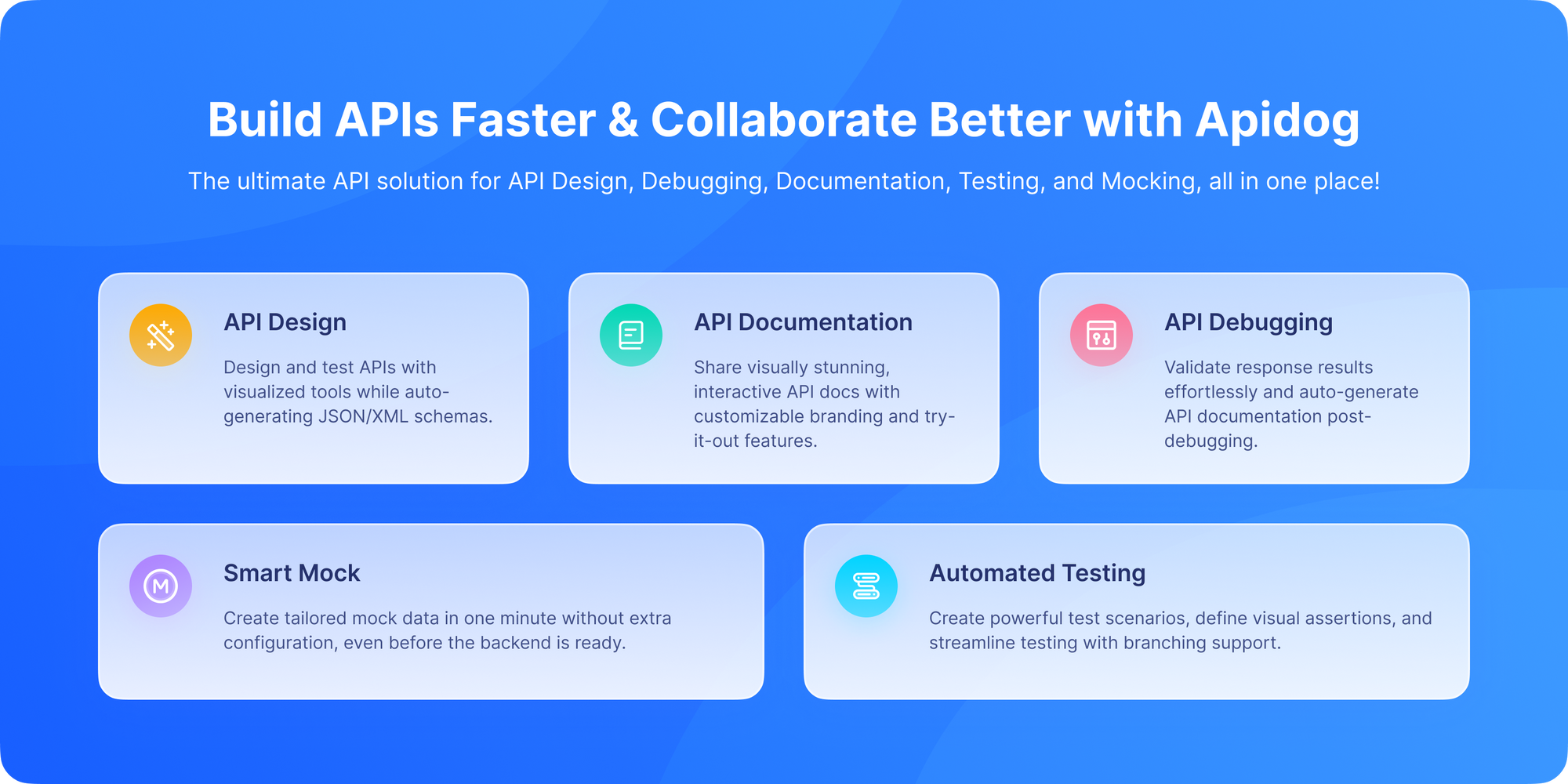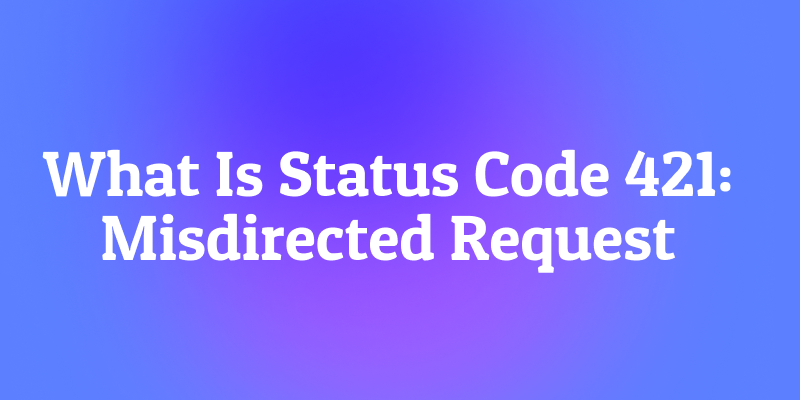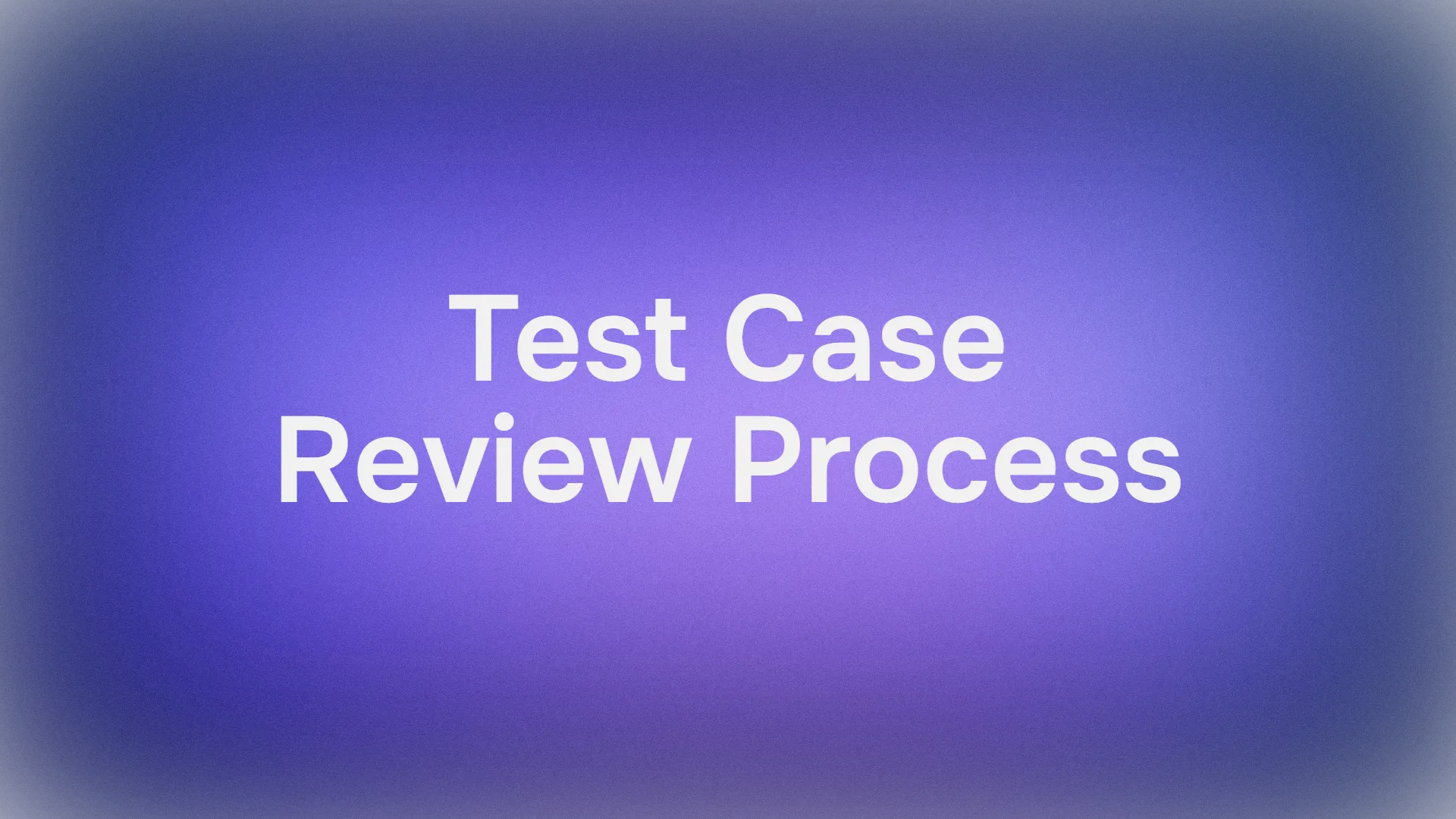You're at an apartment building visiting a friend. You know they live in apartment 4B, so you buzz that specific intercom. But instead of your friend answering, a confused stranger's voice comes through: "I think you have the wrong apartment." The building looks right, the apartment number looks right, but something about your request was misdirected.
This is essentially what happens when a web server responds with the 421 Misdirected Request status code. It's a relatively new and specialized HTTP status that says, "You've reached the right server, but you're using the wrong connection for what you're asking for."
This code is a product of the modern web's evolution, specifically designed to work with HTTP/2's performance optimizations. If you're developing or working with modern web applications, understanding 421 gives you insight into how the web is becoming faster and more efficient.
This HTTP response code doesn't appear as often as the classic 404 Not Found or 500 Internal Server Error, but when it does, it can leave even experienced developers scratching their heads. So today, we're going to unpack exactly what this status code means, why it happens, how to fix it, and how tools like Apidog can help you identify and debug it quickly.
Now, let's explore the world of HTTP/2 connection reuse and the clever solution — that is, the 421 status code.
The Old Way: HTTP/1.1 and the Connection Problem
To understand why 421 exists, we need to understand what problem it solves. Let's go back to HTTP/1.1, the protocol that powered the web for decades.
In HTTP/1.1, when your browser needed to load a web page with many resources (images, CSS, JavaScript), it faced a problem. The protocol could only process one request at a time over a single TCP connection. To load things faster, browsers would open multiple parallel connections to the same server typically 6 to 8 connections.
This worked, but it was inefficient. Each new connection requires a costly "handshake" process to establish, consuming time and resources.
The New Way: HTTP/2 and Multiplexing
HTTP/2, introduced in 2015, revolutionized this with a feature called multiplexing. Instead of multiple connections, HTTP/2 allows many requests and responses to be interleaved together over a single, persistent connection.
Think of it like this:
- HTTP/1.1: Like having 6 separate phone lines to the same office, but you can only talk on one line at a time.
- HTTP/2: Like having one high-capacity fiber optic line that can carry hundreds of simultaneous conversations.
This single connection can handle requests for many different resources all at once, which is much more efficient. But this efficiency creates a new challenge that 421 is designed to solve.
What Does HTTP 421 Misdirected Request Actually Mean?
The 421 Misdirected Request status code indicates that the request was directed at a server that is not able to produce a response. This can be sent by a server that is not configured to produce responses for the combination of scheme and authority that are included in the request URI.
In simpler terms: "You've sent this request on a connection that was established for a different website or service. Please try again on the right connection."
To break that down:
- The client (like your browser or API tool) sent a request to a server.
- But the server that received it realized, "Hey, this request isn't actually supposed to come to me!"
- So it responded with 421 Misdirected Request.
Essentially, the request got misrouted or misdirected, hence the name.
This typically happens in environments involving HTTP/2 connections, reverse proxies, load balancers, or TLS (SSL) misconfigurations.
A Simple Example of 421 in Action
Imagine you have two different websites hosted on the same server:
siteA.comsiteB.com
Now, suppose both share the same IP address but have different SSL/TLS certificates (since they're separate domains).
When your browser establishes an HTTP/2 connection with siteA.com, it reuses that connection for efficiency. However, if it mistakenly tries to send a request for siteB.com over the same connection, the server hosting siteA.com will go:
"Wait a minute, this request isn’t for me it’s for another domain!"
So it responds with a 421 Misdirected Request to signal that the client should send that request elsewhere.
This helps prevent potential data leaks, incorrect caching, or cross-domain mix-ups.
The Technical Definition (According to RFC 7540)
The official definition from RFC 7540 (HTTP/2 Specification) describes it like this:
"The 421 (Misdirected Request) status code indicates that the request was directed at a server that is not able to produce a response. This can be sent by a server that is not configured to produce responses for the combination of scheme and authority that are included in the request URI."
That's the formal version, but let's translate it:
- "Scheme" refers to the protocol (
httporhttps). - "Authority" refers to the domain (like
example.com).
So, a 421 error basically says:
"This server isn't configured to handle the combination of domain and protocol you just sent."
The Connection Reuse Challenge
Here's where things get interesting. HTTP/2 allows a client to reuse an existing connection to a server for multiple different domain names, but only if those domains are hosted on the same server and share the same TLS certificate.
This is common with:
- CDNs (Content Delivery Networks) like Cloudflare or Akamai
- Virtual hosting environments where one server hosts many websites
- Modern cloud platforms that serve multiple domains
The problem occurs when a client tries to reuse a connection for a domain that the server isn't prepared to handle.
Common Causes of a 421 Misdirected Request
Now that we understand what it means, let’s explore why it happens. There are several common reasons this error occurs:
1. HTTP/2 Connection Reuse Issues
HTTP/2 allows clients to reuse connections to improve speed and efficiency.
However, if the client mistakenly reuses a connection for a different domain, the server can’t process it properly resulting in a 421 error.
2. TLS/SSL Certificate Mismatch
If the server’s TLS certificate doesn’t match the domain the client is trying to reach, it triggers a misdirected request.
This often happens in multi-domain hosting environments or shared proxies.
3. Reverse Proxy or Load Balancer Misconfiguration
Reverse proxies and load balancers are designed to route traffic to different backend servers.
If the routing rules are misconfigured say, pointing to the wrong backend service the request ends up misdirected.
4. Virtual Hosting Conflicts
In shared hosting setups, multiple websites might live on the same IP address.
If your virtual host configuration (like Apache’s VirtualHost or Nginx’s server blocks) isn’t correctly set up, the wrong site could receive a request, prompting a 421 error.
5. Caching or DNS Issues
Sometimes, outdated DNS records or cached connections can lead to a mismatch between where the client thinks it’s sending a request and where it actually goes.
A Real-World Example of a 421 Scenario
Let's walk through a concrete example:
Initial Connection: Your browser connects to https://blog.example.com. The server presents a TLS certificate valid for .example.com (which covers both blog.example.com and shop.example.com).
Request Reuse: Your browser, trying to be efficient, decides to reuse this same connection to also request https://shop.example.com. This is allowed because both sites are covered by the same certificate.
The Problem: However, unbeknownst to your browser, blog.example.com and shop.example.com are actually hosted on different backend servers behind a load balancer. The server that handles blog.example.com receives the request for shop.example.com and realizes: "I'm not configured to handle requests for this domain."
The 421 Response: The server responds with:
HTTP/2 421 Misdirected Request
This is the server saying, "I can't process this request for shop.example.com on this connection. Please establish a new connection specifically for that domain."
The Client's Response: Your browser receives the 421 status, understands the problem, opens a new connection to shop.example.com, and resends the request there.
How to Fix the 421 Misdirected Request Error
Once you've identified the cause, here are some ways to fix it effectively.
1. Disable Connection Reuse for HTTP/2
If your environment reuses HTTP/2 connections between different domains, consider disabling connection reuse.
This ensures that each domain uses its own dedicated connection.
In Nginx, for instance, you can disable HTTP/2 connection reuse with:
proxy_http_version 1.1;2. Correct SSL/TLS Certificates
Make sure every domain or subdomain has the correct SSL/TLS certificate installed.
A wildcard certificate (*.example.com) can help if you have multiple subdomains.
3. Fix Proxy and Load Balancer Configurations
Double-check your load balancer or reverse proxy configuration.
Ensure requests are routed to the correct backend server or service.
4. Update DNS or Flush Caches
Clear your DNS cache (ipconfig /flushdns on Windows, sudo dscacheutil -flushcache on macOS).
You can also test using a different DNS resolver like Google’s 8.8.8.8.
5. Restart Your Server
Sometimes, persistent connection issues can linger until the server restarts.
A simple restart might reinitialize connections and clear out stale sessions.
Why 421 is Actually a Good Thing
At first glance, a 421 response might seem like an error, but it's actually a clever recovery mechanism. Without 421, what would happen?
- The server might return a
404 Not Foundor400 Bad Request, which would be confusing and misleading. - The server might just close the connection abruptly, causing the client to retry with potential timeouts.
- The client might get stuck in a loop, repeatedly trying the wrong connection.
The 421 code provides a clear, standardized way to say: "Wrong connection, try again properly." This actually makes the web faster and more reliable by providing a clean recovery path.
421 vs. Other 4xx Status Codes
It's important to distinguish 421 from other client error codes:
421 Misdirected Request vs. 400 Bad Request:
421means "The request is well-formed, but sent to the wrong server/connection."400means "The request itself is malformed or invalid."
421 Misdirected Request vs. 404 Not Found:
421means "I can't handle this request because of connection configuration."404means "I looked for the resource you requested and it doesn't exist on this server."
421 Misdirected Request vs. 421 Misdirected Request:
Wait, what? This highlights that 421 can occur in different scenarios:
- HTTP/2 Connection Reuse: The most common scenario we've discussed.
- Load Balancer Misconfiguration: When a load balancer directs traffic to the wrong backend server.
Testing and Debugging APIs with Apidog

While you might not frequently encounter 421 errors as a user, they're important for developers working with HTTP/2 and complex hosting environments. Apidog is an excellent tool for understanding and testing these scenarios.
With Apidog, you can:
- Test HTTP/2 Connections: Apidog supports HTTP/2, allowing you to experience the multiplexing benefits and potential issues firsthand.
- Simulate Different Domains: Test requests to multiple domains that might be served by the same infrastructure to see if you encounter any connection reuse issues.
- Inspect Detailed Logs: If you do receive a
421response, Apidog's detailed logging helps you understand the context of what domain was requested, what connection was used, and what the server's specific issue was. - Test Load Balancer Configurations: If you're configuring servers or load balancers, you can use Apidog to test whether requests are being properly routed and identify situations that might generate
421responses. - Verify Client Handling: Test how your application or client library handles
421responses. Does it correctly establish a new connection and retry the request?
Best Practices for Handling 421
For Server Administrators:
- Configure Servers Properly: Ensure servers behind load balancers are correctly configured to handle the domains they're supposed to serve.
- Use Appropriate Certificates: Make sure TLS certificates properly cover all domains that might share connections.
- Monitor 421 Responses: Keep an eye on your logs for
421responses, as they can indicate misconfigurations in your hosting environment.
For Client Developers:
- Implement Proper 421 Handling: When your client receives a
421, it should automatically open a new connection to the correct authority and retry the request. - Don't Treat it as a Fatal Error:
421is a recoverable condition. Your application shouldn't show an error to the user for a single421response. - Cache the Lesson: Smart clients can remember which connections work for which domains to avoid repeating the same mistake.
How Developers Can Prevent 421 Errors
Here are some best practices to help you avoid running into this issue in the first place:
- Use Consistent SSL/TLS Certificates: Avoid mismatched or outdated certs.
- Enable SNI (Server Name Indication): Ensures the server can differentiate domains under HTTPS.
- Avoid Connection Reuse Across Domains: Especially with HTTP/2.
- Test Environments Thoroughly: Tools like Apidog can automate and catch routing issues.
- Document Your Proxy Setup: So future devs (and you) know exactly how traffic flows.
421 and Security: Why It Matters
You might think a 421 error is just an inconvenience, but it actually plays a key role in maintaining security.
If a server accidentally processes a request for the wrong domain, it could leak sensitive data or respond incorrectly.
By returning 421 Misdirected Request, the server ensures:
- Isolation between hosted domains
- Secure separation of SSL certificates
- Prevention of data exposure
So, rather than being a "bug", 421 is actually a protective mechanism in many cases.
The Future: HTTP/3 and Beyond
As the web continues to evolve with HTTP/3 (which uses QUIC protocol instead of TCP), the concept of connection reuse becomes even more important. While the specific mechanisms may change, the fundamental problem that 421 solves efficiently managing connections in a complex, multi-domain web will remain relevant.
Conclusion: The Signpost of Modern Web Architecture
The HTTP 421 Misdirected Request status code is more than just an error message; it's a signpost pointing toward the sophisticated, efficient architecture of the modern web. It represents the growing complexity of our online infrastructure while providing an elegant solution to the challenges of connection reuse.
While most users will never see a 421 error, it's working behind the scenes to make the web faster and more reliable. For developers, understanding 421 provides valuable insight into HTTP/2's inner workings and helps build more robust applications that can handle the complexities of modern web hosting.
So the next time you think about how quickly modern websites load, remember the sophisticated connection management happening behind the scenes and the clever 421 status code that helps keep everything running smoothly. And when you're ready to test and understand these advanced HTTP features yourself, a tool like Apidog provides the perfect platform for exploring the cutting edge of web technology.
If you frequently work with APIs, reverse proxies, or multiple domains, then mastering HTTP status codes like 421 is a must. But here's the thing: manually debugging them can be time-consuming. Download Apidog for free today and take the guesswork out of debugging HTTP errors.



